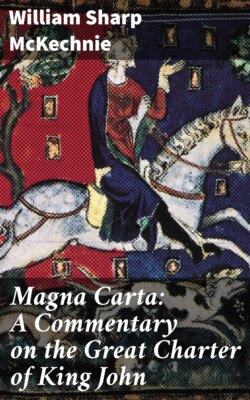Читать книгу Magna Carta: A Commentary on the Great Charter of King John - William Sharp McKechnie - Страница 19
На сайте Литреса книга снята с продажи.
Оглавление140. This account of the relations of the two sets of courts would receive the support of recent writers, such as Maitland and Round, as well as of the older generation, such as Stubbs and Freeman. Mr. Frederic Seebohm may be mentioned as perhaps the most weighty upholder of the opposite view, which regards the manorial courts as of equally early or earlier origin than those of hundred and shire.
141. Cf. “landlord.”
142. The various stages in the gradual process, extending from the reign of Henry I. to that of Edward I., by which royal justice insidiously encroached on feudal justice, may be studied in Professor Maitland’s admirably lucid account prefaced to Sel. Pleas in Manorial Courts, pp. liii. seq. See also Pollock and Maitland, I. 181-2.
143. Sometimes no fore-witnesses were required; for example, to choose an obvious case, where the claim was for the restoration of stolen cattle, which had been traced by “hue and cry” to defendant’s house or byre. The presumption of guilt was here so strong as to render corroborative evidence unnecessary. The plaintiff’s unsupported oath was thus sufficient to put the defendant on his “trial.” On the other hand, in the absence alike of presumption and of witnesses swearing in support of plaintiff’s oath, the defendant escaped without any “trial” at all.
144. See infra under chapters 38 and 39, where the meaning of lex is discussed.
145. Details may be studied in Dr. George Neilson’s Trial by Combat.
146. See infra, chapters 38 and 39.
147. Ordeal and compurgation and other forms of lex are further discussed infra, under chapters 38 and 39.
148. Cf. Thayer, Evidence, p. 8. “The conception of the trial was that of a proceeding between the parties, carried on publicly, under forms which the community oversaw.”
149. These stages of procedure are all fully illustrated by the actual words of recorded cases of the thirteenth century. Two of these, both from the reign of John, one decided by battle, the other by ordeal, may here be cited. (1) "Hereward, the son of William, appeals Walter, the son of Hugh, of assaulting him, in the King’s peace, and wounding him in the arm with an iron fork, and giving him another wound on the head; and this he offers to prove on his body as the Court shall appoint. And Walter defends all of it by his body. And it is testified by the coroners and by the whole county that the same Hereward showed his wounds at the proper time, and has made sufficient suit. Therefore it is decreed that there should be “battle.”... Let them come armed, a fortnight from St. Swithin’s day, at Leicester." Sel. Pleas of Crown (Selden Society), p. 18. (2) “Walter Trenchebof was said to have handed to Inger of Faldingthorpe the knife with which he killed Guy Foliot, and is suspected of it. Let him purge himself by water that he did not consent to it. He has failed and is hanged.” Ibid., p. 75.
150. The relation of “recognition” to trial by jury is fully discussed, infra, Part III., section 7.
151. E.g. 34 and 39.
152. See infra, under chapters 24 and 45.
153. See infra, under chapter 54.
154. See infra, under chapter 36.
155. See infra, under chapters 17 and 24.
156. See infra, under chapter 18.
157. See infra, under chapters 21 and 39.
158. See infra, under chapter 34.
159. c. 34
160. c. 39.
161. c. 21.
162. c. 17.
